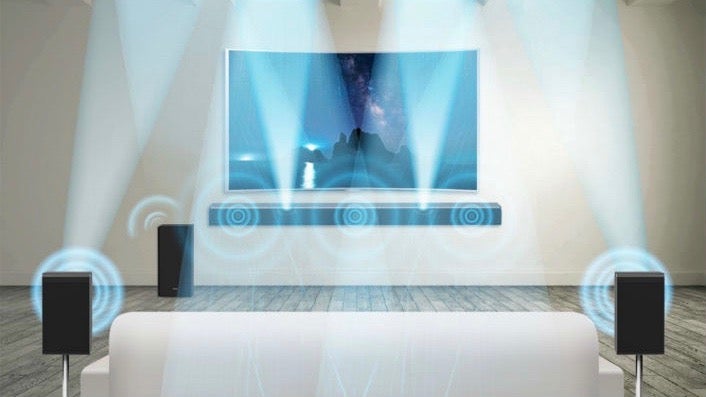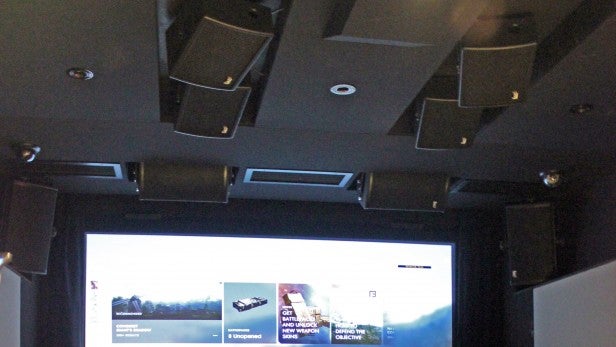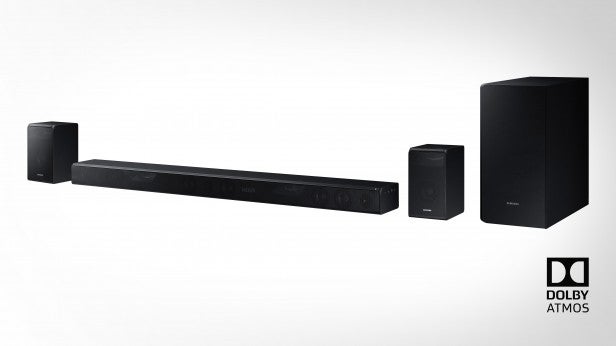Dolby Atmos may make you a better gamer – here’s why

There are many ways to gain an edge in video games; caffeine and a comfy chair often help. But those who are serious will consider upgrading their hardware.
Take a good display, for instance. The extra resolution of Ultra HD (or 4K) improves definition and clarity, while high dynamic range (HDR) helps with lighting and shadow – all the better for seeing your opponents. Then there are less obvious upgrades, such as a more stable router, or a more responsive mouse.
While each of these on their own may be considered minor improvements, they add up to make a significant difference, no matter whether you game casually or competitively.
But how far would you go, what would you do to win and how much would you pay? Recently, I had the opportunity to try Dolby Atmos with gaming: it’s a faff and it’s not cheap, but I’m convinced it’s the ultimate gaming upgrade.
Related: Best Gaming PC
For the uninitiated, Dolby Atmos could be described as surround sound on steroids. Imagine a ring of sound, with you in the middle – that’s what traditional 5.1-channel surround-sound packages offer. Now imagine a dome, where sound comes not just from around you, but from above too – that’s Dolby Atmos.
Traditional surround sound uses “channel-based” audio, which consigns portions of sound effects to specific speakers. Dolby Atmos offers “object-based” audio: sound engineers can specify where an individual sound comes from and goes to, and it’s played back in a virtual 3D space.
It totally works. A good Dolby Atmos system not only adds a sense of height to your sound, but also greater precision in effects placement – which in turn leads to greater immersion. If I had my way, everyone would be watching movies in Dolby Atmos.
Related: What is Dolby Atmos?
Why Atmos for gaming?
I’m a film fan, and I hadn’t really thought about what Dolby Atmos might do for games. To fix that, I was invited to Factory Studios, a sound design and audio production facility in London.
It has a Dolby Atmos-licensed suite for editing commercials and trailers, where 35 speakers are arranged around and above in the space. It was here that I met representatives from EA and DICE, and was invited to play Battlefield 1 in Dolby Atmos.
It was a revelation, pure and simple. I’ve tested quite a few speakers and surround-sound systems in my time as an AV reviewer – and I enjoy video games on a hefty 5.1 system at home – but I can confidently say that I’ve never had a gaming experience nearly as convincing as the one I had in Dolby Atmos.
As it turns out, overhead sound can be surprisingly useful in active combat. I could locate planes and explosions occupying the space above me, even if they weren’t on-screen. Not only is that very cool, the simple sensation of having more space appears to be very effective in placing you within the scene – Normandy, in this case.
Then there’s the matter of effects placement, which is eerily precise thanks to the object-based audio that Dolby Atmos offers. Sure, a traditional 5.1 system lets you know the direction from which your enemies are firing, but here I felt bullets flying past me. One level had me walking through a burning zeppelin, and I didn’t just hear flames all around me – I could tell where specific fires were as I walked past.
Related: Xbox Scorpio vs PS4 Pro
A more accurate sense of space and improved effects precision really helps that sense of immersion, which is even more important in more cinematic titles. But isn’t only about making you feel as if you’re there; it helps gameplay too.
There were a couple of occasions where the accuracy of the sound effects placement saved my virtual life. In one instance, I was dealing with grenade-happy enemies, and I could hear when one got a little too close. Plenty of games provide a handy frag warning, but being able to determine for yourself whether it’s a safe distance away or right behind me makes all the difference.
Another time, I could tell by the sound of footsteps that somebody was charging to stick me with a bayonet, behind me and to the right. I managed to turn around in time to stop him. Essentially, being more aware of my surroundings gave me a slight advantage and, momentarily at least, made me a better gamer. That doesn’t mean I managed to avoid getting shot shortly afterwards, though.

Star Wars: Battlefront was the first game available with Dolby Atmos
How it works
Now, anyone who’s seen a movie in Dolby Atmos might say the above improvements are all very obvious. If movie audio is improved, why wouldn’t game audio automatically benefit? Well no, because they’re built differently. Movies are a prescribed experience, with one sound design. In games, that sound design is always changing, because you’re in control of where you go and which direction you face.
It’s the reason surround sound for games tends to be a little ropey, sometimes going haywire as sound effects struggle to follow your camera angle adjustments.
The fluid nature of games means that flexibility of sound is important, and that’s something at which object-based audio excels. At no point in my demo was I aware that sound effects were switching between speakers; they just moved across the room seamlessly. It’s early days, but I reckon Dolby Atmos and VR headsets are natural bedfellows. I use my PSVR with my 5.1 speaker system and it does the job – I can only imagine it being a lot better with the precision offered by Atmos.
The sound design is a little trickier at the back-end. DICE’s audio director Ben Minto made me aware of the fact that audio production for Atmos and non-Atmos games are different processes.
“In the non-Atmos world, we’ve been ‘compressing’ the 3D representation of sound down into a flat horizontal plane. This could be stereo, 5,1, 7.1, and so on – and we mix for what should come out of each speaker. When you render to a fixed number of channels/speakers, you can apply traditional mastering practices such as compression, limiting and EQ to the final mix.
“In the Atmos version, instead of having up to eight discrete channels to master, you can now have a fixed eight-object bed and then also up to 56 free objects that can exist anywhere in space. These can’t be mastered in the traditional channel-based way, so the DICE Audio team had to develop new techniques for how to handle mixing those free objects.”

The Samsung HW-K950 – a stunning Atmos soundbar
How do you build a Dolby Atmos gaming system?
I’m very aware that I’m singing the praises of a system that surrounded me with 35 speakers. But you don’t need such excess to get Dolby Atmos working in your home, because Atmos is scalable. If you have an existing 5.1 system, you can make it an Atmos system by adding an Atmos-compatible AV amp, plus two ceiling speakers. It’s still a faff, but at least you won’t have to reconstruct half your living room. An AV amp can cost as little as £400, and I’ve seen ceiling speakers go for around £100 each.
What if you don’t want to drill holes in your ceiling? You can buy up-firing Atmos speakers, or Atmos speaker modules which sit on top of your existing speakers. These shoot sound at your ceiling, which bounces down towards your sofa, creating the illusion of sound from above. These are more convenient, but also more expensive, ranging from £600 to £1200.
Even more convenient are Dolby Atmos soundbars, which take that upfiring/bouncing idea and shrink it down further – you wouldn’t even need an AV amp. Again, you’ll pay for the convenience: the Samsung HW-K950, for instance, costs £1300.
As for what drives the system, you need a PC. Atmos has yet to hit consoles; Microsoft has announced that the Xbox One will get Atmos with a software update in 2017, but there’s no set date. It’s also worth noting the only Atmos-compatible games so far are Star Wars: Battlefront, Battlefield 1 and Overwatch.
Related: Best Soundbars
Is it worth it?
It’s hard to get away from the fact that Dolby Atmos requires significant investment in time, money and space. But if you’re inclined to go down this path, you will be rewarded.
Sure, there’s not that much you can play right now, but from what I could tell, Battlefield 1 benefits massively from Atmos – and more games are sure to follow. Maybe three games is too small a library to justify a complete system overhaul, but if you were already considering Atmos for movies, then Atmos gaming is another compelling reason to make the jump.
Having tried it, I’m utterly convinced that a most games would be improved by Dolby Atmos: the active nature of games makes them a better fit for Atmos over movies. Atmos offers a more believable gaming experience – and you just might perform better too.

